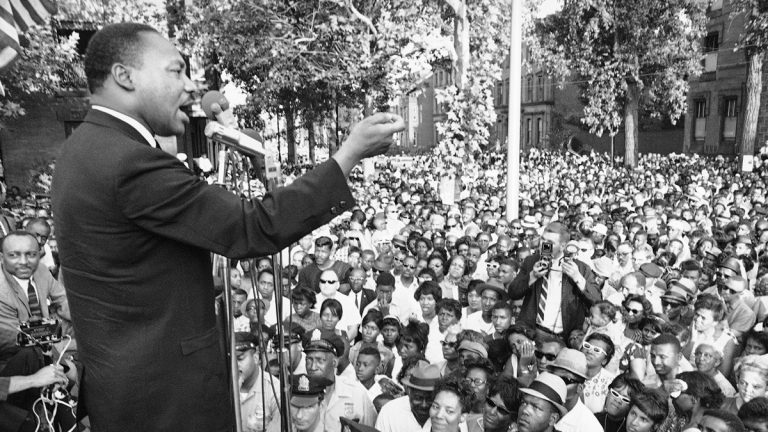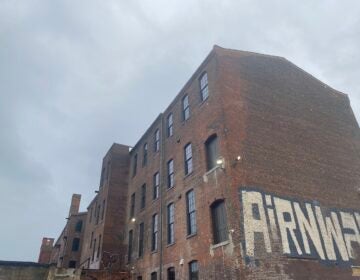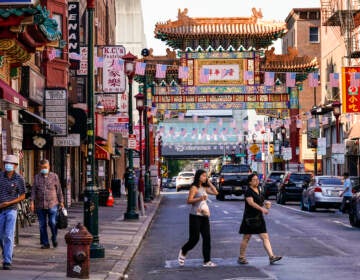Retracing Martin Luther King Jr.’s steps through Philadelphia

On Monday, Philadelphia and the nation will commemorate the 89th anniversary of Martin Luther King Jr.’s birth. A chapter of the civil rights hero’s life unfolded here in the Philly region and in honor of the indelible mark he left, Curbed Philly retraces his steps through the city. Sites of significance include the corner of 40th and Lancaster Avenue in West Philadelphia where Dr. King delivered a historic 1965 speech that drew a crowd of 10,000 and Bright Hope Baptist Church on 12th Street and Cecil B. Moore in North Philadelphia, which was visited by King in 1964 for a dedication service in its then-new sanctuary. “Here he called out churches for acting as ‘taillights rather than headlights of the civil rights movement,’” Curbed reports. Another site worth a visit: the intersection 13th Street and Fitzwater Street in the Hawthorne neighborhood. On August 3, 1965, King gave a speech on the South Philly corner, then home to a vibrant black community. 44 years later in 1999, Philadelphia Housing Authority officials imploded four long-neglected public housing towers on the site and began the development of Martin Luther King Jr. Plaza, a 250-unit mixed-income rowhome development.
Not too far from the Baptist church dedicated by King, Tioga Family Center, supportive and affordable housing for single parents and single heads of households, celebrated its opening Thursday morning, KYW reports. Built on an empty lot and designed by Cecil Baker + Partners, the low-rise development at 1822-1826 West Tioga Street complies with Pennsylvania Housing Finance Agency’s latest sustainability requirements and features community amenities including a kid-friendly outdoor green space.
How did a residential section of Fishtown end up with a 90-foot-tall, illuminated “vending machine for cars,” asks Inga Saffron. The Inquirer architecture critic explores the city’s previous considerations for the site, including a mixed-use, mid-rise development proposed by Onion Flats and a parking lot for the Fillmore. Cut to present day: the Zoning Board will next decide a crucial variance that could determine whether the Phoenix-based startup behind the glass and steel tower, likened to “the Match.com of the second-hand car business,” can move forward with the project.
Are there ways to keep more taxpayer dollars circulating in Philadelphia? Tivoni Devor, contributing to Generocity, has two ideas: committing one percent of the city’s $4 billion municipal pension fund to a new job-generating economic development fund and creating a public bank operated through government-owned institutions. An idea that’s been thrown around by the City Council several times over the past few years, the taxpayer-owned bank would handle the city’s $3 billion-plus in payroll, deposits, and investments, creating a pool of capital for loans to businesses, nonprofits and individuals in Philadelphia. The concept is gaining steam in cities such as Oakland and Seattle, but as of now, the state of North Dakota operates the only functioning taxpayer-owned local bank, the Bank of North Dakota.
How is pollution in Philadelphia changing the bug population? As it turns out, humans are not the only ones adapting to life in the city—animals, reptiles, and bugs are adapting, possibly evolving, too. The Pulse’s Alan Yu looks at the street smarts of urbanized creatures compared to their country cousins in Philadelphia, New York City, and San Juan, Puerto Rico.
This week’s episode of The Pulse focuses on ‘Making Cities Work,’ with segments on white roofs for cooler houses, Detroit farms and the future of urban agriculture, and demolitions linked to lead.
WHYY is your source for fact-based, in-depth journalism and information. As a nonprofit organization, we rely on financial support from readers like you. Please give today.







